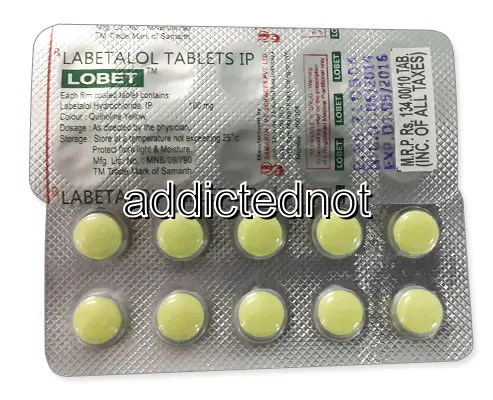| Package | Dosage | Price | Price per Dose | |
|---|---|---|---|---|
| Dosage: 50mg | ||||
| 180 pill | 50mg | $422.73 | $2.35 | |
| 120 pill | 50mg | $285.76 | $2.38 | |
| 90 pill | 50mg | $216.43 | $2.40 | |
| 60 pill | 50mg | $145.41 | $2.42 | |
| 30 pill | 50mg | $74.39 | $2.49 | |
| Dosage: 100mg | ||||
| 180 pill | 100mg | $879.30 | $4.89 | |
| 120 pill | 100mg | $645.95 | $5.38 | |
| 90 pill | 100mg | $532.65 | $5.92 | |
| 60 pill | 100mg | $390.60 | $6.51 | |
| 30 pill | 100mg | $214.74 | $7.15 | |
| Dosage: 200mg | ||||
| 120 pill | 200mg | $1,173.54 | $9.77 | |
| 90 pill | 200mg | $967.24 | $10.74 | |
| 60 pill | 200mg | $710.20 | $11.84 | |
| 180 pill | 200mg | $539.41 | $2.99 | |
| 30 pill | 200mg | $390.60 | $13.02 | |

Labetalol Description
Introduction to Labetalol
Labetalol is a medication commonly used to manage high blood pressure, offering an effective way to control hypertension. It belongs to a class of drugs known as beta-blockers, which work by blocking certain receptors in the body that influence heart rate and blood pressure. Because of its unique properties, Labetalol is often preferred in cases where quick and reliable blood pressure reduction is necessary, such as during hypertensive emergencies.
How Labetalol Works
The primary mechanism of Labetalol is its ability to block both beta-adrenergic and alpha-adrenergic receptors. This dual action causes a decrease in heart rate, cardiac output, and peripheral vascular resistance. As a result, blood vessels relax, and blood flows more smoothly through the circulatory system. This multi-receptor activity allows Labetalol to effectively lower blood pressure without excessively reducing the heart rate, making it suitable for various patient profiles.
Usage and Administration
Labetalol is available in different forms, including oral tablets and intravenous injections. The dosage depends on the severity of the condition and how the patient responds to the medication. Typically, healthcare providers start with a low dose and adjust it accordingly. When taken orally, it is usually administered with or without food, but consistent timing improves its effectiveness. Regular monitoring of blood pressure is essential to determine the correct dosage and prevent potential side effects.
Benefits of Labetalol
The medication is effective in lowering high blood pressure and reducing the risk of complications such as strokes, heart attacks, or kidney problems. Its ability to block both beta and alpha receptors offers a balanced approach to blood pressure control. Additionally, Labetalol can be useful in specific situations such as pregnancy-induced hypertension, provided it is prescribed by a healthcare professional familiar with its use in pregnancy.
Possible Side Effects
While Labetalol is generally well-tolerated, some users may experience side effects. Common reactions include dizziness, fatigue, nausea, and headache. In some cases, patients might notice changes in heart rate or blood pressure, which require medical attention. Rare but serious side effects can include bronchospasm, allergic reactions, or liver problems. Patients should always inform their healthcare provider of any unusual symptoms while taking this medication.
Precautions and Interactions
Before starting Labetalol, it is crucial for patients to disclose their full medical history, especially if they have asthma, heart failure, or allergies to similar drugs. The medication can interact with other drugs such as other antihypertensives, certain antidepressants, or medications for asthma, potentially altering their effects or increasing side effects. Careful dosing and regular monitoring are necessary to minimize these risks.
Conclusion
Labetalol remains a valuable medication for controlling hypertension due to its dual-action properties and effectiveness. Proper use under medical supervision ensures optimal benefits while minimizing potential risks. Patients should follow their healthcare provider’s instructions, report any side effects promptly, and attend regular checkups to achieve the best outcomes from their treatment with Labetalol.
